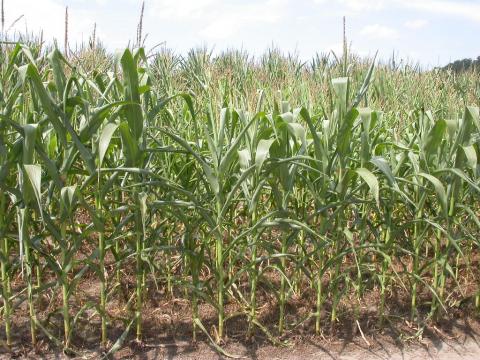Managing Drought Stressed Corn

It’s been a dry season; preciption has been below normal since March, and most locations are seeing 25% or less of their normal preciptiation this week. As of this writing, the entire state is in either a Moderate or Severe drought
The lack of rainfall has taken its toll on a number of cornfields throughout the state, which in turn raises concerns about the quality of feed to be harvested. Moisture stress during tasseling and silking results in poor pollination, which in turn results in poorly filled ears. If your fields have endured prolonged periods of moisture stress, it’s likely that the levels of protein, energy, and fiber will be different from what you usually harvest. Test your feed frequently, and work closely with your nutritionist to figure out how to use your feed most effectively.
A more immediate concern is the issue of nitrate poisoning. Normally, plants take up nitrogen in the form of nitrate and convert it to protein or use it for growth. Under drought conditions, however, the plant cannot complete this conversion and nitrates accumulate in plant tissue. If nitrate levels get too high, the harvested feed can actually be toxic to livestock. Excess nitrate can’t be metabolized quickly enough, so it enters the bloodstream and binds to hemoglobin. This prevents blood cells from being able to transport oxygen, and the animal dies from asphyxiation.
The more severe the drought stress, the higher the risk for nitrate toxicity. Be on the lookout for corn where the ears are absent or severely stunted, or where the leaves have started to dry and turn brown. If any of your corn is in this high-risk category, take the following measures:
- Chop at a height of 12-18”. The highest concentrations of nitrates are usually in the bottom third of the stalk, so it’s better to leave that portion of the plant in the field than to put it in the silo.
- Harvest at a whole-plant dry matter of 30-35% for optimal ensiling.
- Be aware that a good soaking rain after a droughty period can actually make nitrate accumulation worse. Plants can’t take up a lot of nutrients when it’s dry, but they start up again once there’s sufficient moisture in the soil. It can take 3-4 days for plants to metabolize the nitrates they take up into proteins. If you can, wait several days (some experts recommend up to two weeks) after a rain event before chopping.
- Avoid feeding greenchop corn; let it ferment for at least three weeks, as the ensiling process reduces nitrate concentrations by up to 50%. If you can, separate feed from high-risk fields in order to manage it in the ration more easily.
- Once the corn has fermented, have it tested for nitrate levels. For lactating animals, the ration should contain less than 0.44% nitrate, or less than 0.1% nitrate-nitrogen. If your feed is moderately high in nitrates, you can still feed it to as long as you dilute it with other forages to meet these guidelines.
- If you store feed in an upright silo, avoid entering the silo. Nitrates convert to deadly silo gases dioxide and nitric oxide, and they can accumulate to deadly levels in a closed silo environment. If you must enter the silo, run the blower for at least 15-30 min. before doing so. Keep the area ventilated as much as possible, and leave at the first sign of irritation in the throat or lungs.
